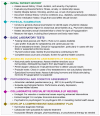Association of Sexual Health and Mental Health in Erectile Dysfunction: Expert Opinion From the Indian Context
- PMID: 39991330
- PMCID: PMC11845324
- DOI: 10.7759/cureus.77851
Association of Sexual Health and Mental Health in Erectile Dysfunction: Expert Opinion From the Indian Context
Abstract
Erectile dysfunction (ED) is a common condition in men, driven by a complex interplay of organic, relational, and psychological factors, necessitating an integrated treatment approach. Psychological factors, such as anxiety, depression, and stress, are significant contributors to erectile problems. Erectile dysfunction can have severe psychological consequences, including feelings of emasculation, humiliation, reduced self-confidence, isolation, loneliness, and a decline in overall well-being. A national advisory board comprising 12 experts from India, including 9 urologists and 3 psychiatrists, convened to discuss a multidisciplinary approach to the treatment of ED. Using a modified Delphi method and literature review, the 34 panels developed evidence-based insights. Experts highlighted the importance of thorough assessments of sexual dysfunction in patients. Given the frequent comorbidity of mental health issues with ED, physicians should proactively explore patients' sexual and mental health. Creating a secure and welcoming environment is crucial for these assessments. Physicians should gather detailed information on psychological symptoms, stressors, relationship dynamics, cognitive style, and distractions. Experts highlighted the importance of thorough diagnostic assessments and recommended a multidisciplinary approach integrating pharmacological interventions (e.g., phosphodiesterase-5 inhibitors) with psychometric therapy, tailored to the age, existing comorbidities, and underlying causes of ED. A balanced, interdisciplinary approach incorporating psychosexual therapy, lifestyle modifications, and advanced therapies is crucial for the holistic management of ED. Key consensus recommendations also emphasized fostering open communication between patients and healthcare providers, routine mental health screenings in patients with ED, and early referrals to specialists when necessary. Clinicians should actively involve mental health professionals in the management of ED and prioritize individualized treatment strategies tailored to each patient's needs. This multifactorial condition requires coordinated efforts to address both organic and psychogenic causes, restore patients' quality of life, and promote open communication. By proactively engaging with patients, addressing their concerns, and facilitating referrals as needed, clinicians can significantly improve outcomes for patients with ED.
Keywords: anxiety; depression; diabetes mellitus-induced erectile dysfunction; endothelial dysfunction; erectile dysfunction; mental health; phosphodiesterase-5 inhibitors; psychosexual therapy.
Copyright © 2025, Vasan et al.
Conflict of interest statement
Conflicts of interest: In compliance with the ICMJE uniform disclosure form, all authors declare the following: Payment/services info: This review article was funded by Mylan Pharmaceuticals Private Limited, A Viatris Company. Financial relationships: Dhara Shah and Zenifer Khan declare(s) employment from Mylan Pharmaceuticals Private Limited, A Viatris Company. Other relationships: All authors have declared that there are no other relationships or activities that could appear to have influenced the submitted work.
Figures




References
-
- Pharmacology and perspectives in erectile dysfunction in man. Mitidieri E, Cirino G, d'Emmanuele di Villa Bianca R, Sorrentino R. Pharmacol Ther. 2020;208:107493. - PubMed
-
- The likely worldwide increase in erectile dysfunction between 1995 and 2025 and some possible policy consequences. Ayta IA, McKinlay JB, Krane RJ. BJU Int. 1999;84:50–56. - PubMed
-
- The global prevalence of erectile dysfunction: a review. Kessler A, Sollie S, Challacombe B, Briggs K, Van Hemelrijck M. BJU Int. 2019;124:587–599. - PubMed
Publication types
LinkOut - more resources
Full Text Sources
